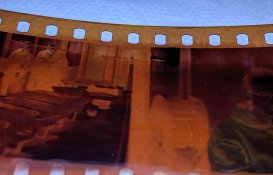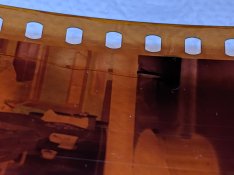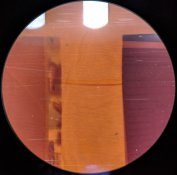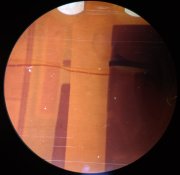The last images the film looks pretty rough like it was mishandled and abraded as well. Did that happen after processing?
Oh yeah that's likely after processing. My scanner (Pakon F-135) has some very slight issues with its take-in mechanism which causes small scratches (These are not deep enough to show up on scans).
They look very extreme on the shots because the light is being reflected off the film instead of through (as usually would be the case)
The scanner had some issues scanning the film because the lines going through had it confused where to split frames. This meant the film went 4 times through the troubled take-in mechanism.
Also because its ruined I didn't take too much care about it, I just kinda put it on my bench where the microscope is at. Might have contributed slightly as well.
IF the lines were caused by light contamination, then it could have happened either:
A. During the manufacturing process (before it went into the cartridge at Cinestill). Supporting this theory is at least one other example (link, post #8)
B. In the camera. IF caused by a light leak in the camera, it would have most like been during the rewind process (lines go across all frames, including the gaps between frames). If it happened in the camera, I would expect the lines to be more straight than they are. I don't think it's very likely that the lines were generated in the camera.
C. In the changing bag. First, I assume you do not wear an iWatch or an analog watch with a luminous dial while loading film(?) The lines might possibly be consistant with a pinhole in the changing bag letting light streak across the film as it was wound on the reel? But if you're like me, the process of wrapping the film onto the reel includes several stops and starts and checks - so I would expect the lines to vary more in brightness and width and position as the film is moved around.
D. In the tank. I don't think so. A leak in the tank would result in one end of the film getting much more exposure than the other end.
So, *IF* caused by exposure to light, the most like theory to me is A. It's also the most easily proved. Have a lab process the next roll, which would rule out B and C. And if you have another film camera, you could rule out B as well.
B: I've had many shots run through this camera, which never had this issue. I'm planning on just developing the Cinestill 800T thats in there right now (With just 12 shots).
If the camera is the issue then on this test after about 12 frames the lines should stop, as this part of the film would've never left its canister. I'll probably develop again tomorrow as I'm just too interested about what might have happened.
C: The watch goes off during development, the bag is already very tight, don't want to try and get my watch through it. Also right after I've developed this film, I've developed another film (120) which came out without problems.
D: Same as for answer C, I developed another film right after without trouble.
Currently I'm with A as well, but maybe I'm slightly biased because its the only answer that would not be kinda my fault

If you are in doubt about the film, exchange it for something more reliable, and try to get a refund from the store/maker, otherwise, process a short roll of B&W in the same tank, reel and top and see if it has the same markings.
I'll develop the Cinestill 800T (Same batch, bought at the same time) thats currently in my camera tomorrow, It currently only has 12 shots but I just don't want to risk it being another disappointment.
-------
This is the film and canister in question, wondering if anyone else has the same batch (B0664-A/4935) and has had good experience with it?













 )
)




